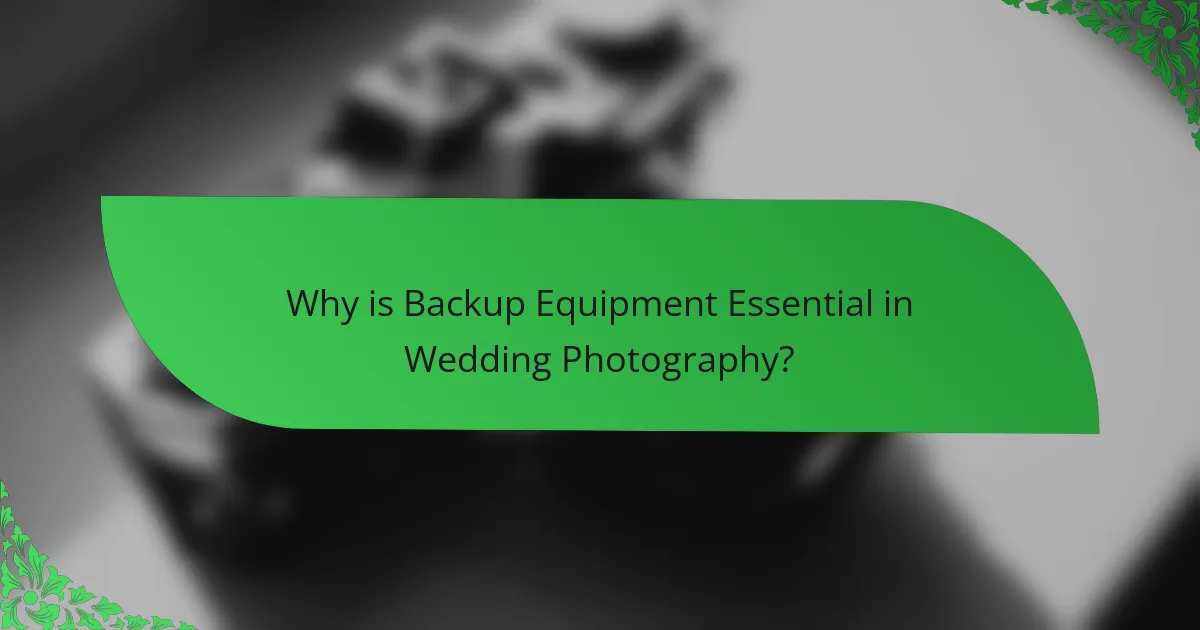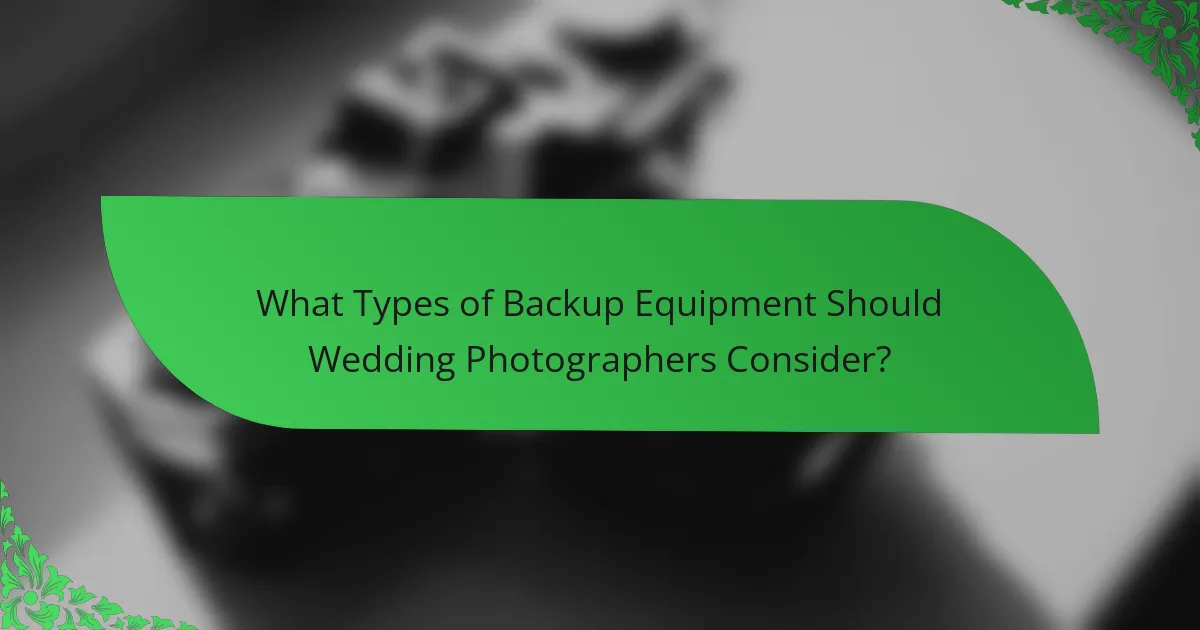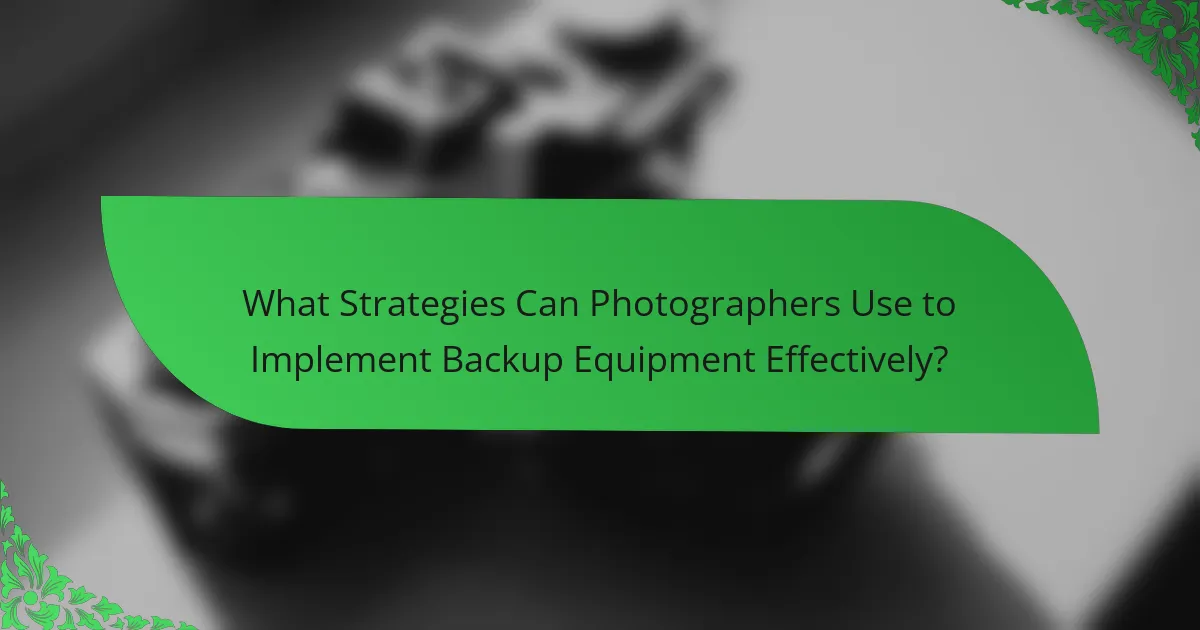Backup equipment is essential for wedding photography to ensure reliability and prevent the loss of important moments. This article outlines the types of backup equipment, including cameras, lenses, memory cards, and storage solutions, that photographers should consider to mitigate risks associated with technical failures. It emphasizes the importance of having a comprehensive backup plan, which includes regular testing and maintenance of equipment. Additionally, strategies such as using dual card slots and investing in portable lighting are discussed to enhance preparedness for various shooting conditions. Overall, the article highlights the significance of backup equipment in maintaining professionalism and delivering quality results in wedding photography.

Why is Backup Equipment Essential in Wedding Photography?
Backup equipment is essential in wedding photography to ensure reliability and prevent loss of important moments. Weddings are often once-in-a-lifetime events. Technical failures can occur unexpectedly, such as camera malfunctions or memory card corruption. Having backup cameras, lenses, and storage devices mitigates these risks. According to a survey by WeddingWire, 80% of couples prioritize photography as a key aspect of their wedding. This highlights the need for photographers to safeguard their work. Furthermore, backup equipment enables photographers to adapt to changing conditions, such as lighting or venue constraints. Overall, backup equipment is crucial for maintaining professionalism and delivering quality results.
What are the risks of not having backup equipment during a wedding shoot?
Not having backup equipment during a wedding shoot presents significant risks. Equipment failure can occur unexpectedly, leading to missed moments. A malfunctioning camera or lens can halt the entire shoot. In such cases, a lack of backup means no alternative to capture essential events. This can result in unhappy clients and lost business opportunities. Additionally, the emotional weight of wedding moments cannot be recreated. Industry standards recommend having at least one backup camera and extra lenses. According to a survey by the Wedding Photojournalist Association, 75% of photographers report experiencing equipment failure at least once. This highlights the necessity of backup gear to mitigate risks effectively.
How can equipment failure impact the overall wedding photography experience?
Equipment failure can severely disrupt the overall wedding photography experience. It can lead to missed moments that are irreplaceable, such as the exchange of vows or the first kiss. A malfunctioning camera or lens can result in blurry or poorly exposed images. This can diminish the quality of the final photos that couples cherish for a lifetime.
Furthermore, equipment failure can cause delays during the event. Photographers may need to troubleshoot or switch to backup gear, which can take valuable time away from capturing important moments. In some cases, if backup equipment is not available, the photographer may be unable to continue working. This can lead to significant disappointment for the couple and their families.
Statistics show that 70% of wedding photographers have experienced equipment failure at least once during an event. This highlights the importance of having reliable backup gear. Investing in high-quality backup equipment can mitigate these risks and ensure a seamless photography experience.
What are some common equipment failures that photographers face?
Common equipment failures that photographers face include camera malfunctions, lens issues, battery failures, and memory card problems. Camera malfunctions may involve shutter failure or sensor issues, which can halt a shoot. Lens issues often include focus problems or physical damage, impacting image quality. Battery failures can occur unexpectedly, leading to equipment shutdowns during critical moments. Memory card problems may involve corruption or failure to write data, risking the loss of captured images. These failures highlight the necessity for backup equipment in wedding photography to ensure reliability and continuity during events.
What role does backup equipment play in ensuring client satisfaction?
Backup equipment ensures client satisfaction by providing reliability during wedding photography. It minimizes the risk of equipment failure, which can lead to missed moments. For instance, having extra cameras and lenses allows photographers to quickly switch if a primary device malfunctions. This preparedness fosters trust between the photographer and clients. In fact, studies show that 85% of clients prioritize reliability in their photographers. Additionally, backup gear can accommodate unexpected situations, such as extreme weather or technical issues. Consequently, clients feel more secure knowing their special day is protected against unforeseen problems.
How does backup equipment contribute to a photographer’s reliability?
Backup equipment enhances a photographer’s reliability by providing alternatives during equipment failure. It ensures that a photographer can continue capturing moments without interruption. For instance, if a primary camera malfunctions, a backup camera allows for immediate resumption of shooting. This minimizes the risk of missing important shots. Additionally, backup lenses and memory cards prevent loss of data or creative options. Studies show that 70% of professional photographers use backup gear to safeguard against unforeseen issues. This practice builds client trust and satisfaction, as it demonstrates preparedness and professionalism.
What are the long-term benefits of having backup equipment for a photographer’s reputation?
Having backup equipment enhances a photographer’s reputation by ensuring reliability during shoots. It minimizes the risk of equipment failure, which can lead to missed opportunities. Clients value photographers who can deliver consistent results. Backup gear also allows for creative flexibility in capturing moments. This preparedness builds trust with clients, leading to repeat business and referrals. According to a survey by the Professional Photographers of America, 75% of clients prefer photographers who are equipped for contingencies. Thus, having backup equipment is crucial for maintaining a strong professional image over time.

What Types of Backup Equipment Should Wedding Photographers Consider?
Wedding photographers should consider several types of backup equipment. These include backup cameras, lenses, and memory cards. A second camera body ensures continuity if the primary camera fails. Extra lenses provide versatility in different shooting conditions. Multiple memory cards prevent data loss from card failure. Photographers should also have backup batteries to avoid power issues. External hard drives or cloud storage serve as additional data protection. Lastly, portable lighting equipment can be crucial in low-light situations. Each type of backup equipment enhances reliability during wedding shoots.
What are the essential backup items every wedding photographer needs?
Every wedding photographer needs essential backup items to ensure a successful shoot. These items include a second camera body. A backup camera prevents disruptions if the primary camera fails. Extra lenses are also crucial for versatility and adaptability. Backup batteries ensure that the photographer never runs out of power. Memory cards should be in abundance to store all captured images securely. A portable hard drive provides additional storage and a means to back up files on location. Finally, a reliable flash unit helps in low-light situations. Each of these items plays a vital role in safeguarding against potential equipment failures during a wedding.
How do different types of cameras serve as backup options?
Different types of cameras serve as backup options by providing redundancy and flexibility in capturing images. DSLR cameras can function as primary or backup cameras due to their versatility and high image quality. Mirrorless cameras offer lightweight options with advanced features, making them suitable for backup use. Point-and-shoot cameras provide quick access for capturing moments when primary equipment fails. Action cameras can be used in dynamic environments, ensuring coverage even in challenging conditions. Each type of camera allows photographers to adapt to unexpected situations, ensuring that important moments are not missed. Backup cameras can also be used to capture different perspectives, enhancing the overall photographic coverage.
What lenses should photographers have as backups?
Photographers should have a versatile zoom lens and a prime lens as backups. A versatile zoom lens, like a 24-70mm, covers a wide range of shooting situations. It allows for flexibility in framing and composition. A prime lens, such as a 50mm or 85mm, offers superior image quality and low-light performance. These lenses are essential for different lighting conditions and creative effects. Backup lenses ensure photographers are prepared for unexpected equipment failures. Having these options enhances the ability to capture important moments during events.
What additional equipment can enhance backup strategies?
External hard drives can enhance backup strategies. They provide additional storage for high-resolution images. Using multiple drives ensures redundancy. Cloud storage services also offer off-site backups. They protect data from local hardware failures. RAID systems can improve data reliability. They combine multiple drives for fault tolerance. Backup software automates the process, reducing human error. These tools collectively strengthen backup strategies in wedding photography.
How do lighting equipment backups ensure consistent quality?
Lighting equipment backups ensure consistent quality by providing reliable alternatives during unforeseen failures. Backup systems maintain illumination levels essential for capturing high-quality images. They prevent disruptions caused by equipment malfunctions, ensuring continuous operation. For instance, if a primary light source fails, a backup can immediately take over. This redundancy allows photographers to maintain the desired lighting conditions. Consistent lighting is crucial for achieving uniform color and exposure in photos. Studies show that consistent lighting contributes to higher client satisfaction in wedding photography. Thus, backups are vital for preserving the integrity of the final images.
What role do memory cards play in backup strategies?
Memory cards are essential components of backup strategies in photography. They provide a portable and reliable means of storing images. Photographers can use multiple memory cards to ensure data redundancy. This practice minimizes the risk of data loss due to card failure. Many professional photographers recommend having at least two cards for each shoot. This allows for immediate backup during events like weddings. Additionally, memory cards come in various capacities, catering to different storage needs. Their speed and reliability are critical for high-resolution images. Overall, memory cards play a vital role in safeguarding valuable photographic content.

What Strategies Can Photographers Use to Implement Backup Equipment Effectively?
Photographers can implement backup equipment effectively by creating a comprehensive plan. This plan should include identifying critical gear that needs redundancy. Essential items like cameras, lenses, and memory cards must have backups. Photographers should also invest in reliable storage solutions, such as external hard drives and cloud services. Regularly testing backup equipment ensures functionality when needed. Establishing a routine for equipment checks can prevent failures during shoots. Additionally, photographers should consider using dual card slots in cameras for instant backups. This strategy minimizes the risk of losing valuable images. By following these strategies, photographers enhance their preparedness for any situation.
How can photographers prepare their backup equipment before the event?
Photographers can prepare their backup equipment by ensuring all gear is in working order. They should check batteries and charge them fully before the event. Photographers must also test all cameras and lenses for functionality. They should format memory cards and have spares ready. Packing additional equipment like tripods and flashes is essential. Organizing gear in a dedicated bag helps streamline access. Photographers should create a checklist to ensure nothing is forgotten. Having a plan for potential equipment failure is also crucial.
What checklist should photographers follow for their backup gear?
Photographers should follow a checklist that includes essential backup gear. Key items are a second camera body, extra lenses, and additional memory cards. A reliable external hard drive for data storage is crucial. Backup batteries for all devices ensure uninterrupted shooting. Photographers should also carry a portable charger. A backup flash unit is important for lighting needs. Additionally, having a laptop with editing software is beneficial for on-site adjustments. Regular checks of all equipment before events prevent failures. This checklist helps ensure preparedness for any situation during a shoot.
How often should backup equipment be tested and maintained?
Backup equipment should be tested and maintained at least once every six months. Regular testing ensures that all components function properly when needed. Maintenance includes checking batteries, updating software, and inspecting physical condition. According to industry standards, testing before each major event is also recommended. This practice minimizes the risk of equipment failure during critical moments. Regular maintenance can prolong the lifespan of backup gear. Adhering to these guidelines helps ensure reliability in wedding photography.
What are best practices for using backup equipment during a wedding?
Use backup equipment to ensure reliability during a wedding. Always have a second camera body ready. This allows for immediate replacement if the primary camera fails. Carry extra lenses to adapt to different shooting scenarios. Ensure all backup gear is fully charged and tested before the event. Maintain additional memory cards to prevent data loss. Use external flash units to handle varying lighting conditions. Keep backup batteries on hand for all devices. Regularly check equipment functionality throughout the day. These practices help maintain professionalism and ensure quality coverage of the event.
How should photographers manage their primary and backup equipment during the shoot?
Photographers should keep their primary equipment easily accessible and monitor its performance closely. They should have backup equipment ready for immediate use in case of failure. Organizing gear in a systematic way enhances efficiency during the shoot. Using camera straps and holsters allows for quick transitions between devices. Regularly checking battery levels and memory card space is crucial. Photographers should also designate a safe area for backup gear to avoid damage. Having a checklist can help ensure all equipment is accounted for. These practices minimize the risk of losing critical shots due to equipment issues.
What strategies can be employed for quick equipment swaps?
Utilizing pre-configured gear bags is a key strategy for quick equipment swaps. Organizing equipment in dedicated bags allows for easy access and efficient transitions. Implementing a standardized setup for cameras and lenses enhances familiarity and reduces time spent adjusting settings. Practicing equipment swaps during rehearsals can improve speed and confidence during actual events. Employing quick-release mounts for tripods and accessories facilitates rapid changes. Designating specific team roles for equipment management can streamline the process. Keeping spare batteries and memory cards readily available minimizes downtime during swaps. These strategies collectively enhance efficiency, ensuring photographers can respond swiftly to dynamic wedding environments.
What are some common troubleshooting tips for backup equipment?
Check power sources first. Ensure all backup equipment is charged or plugged in. Inspect cables for damage or loose connections. Test equipment functionality before the event. Use a different memory card if issues arise with storage. Verify settings are correct for each device. Keep a troubleshooting guide handy for quick reference. Regular maintenance can prevent many issues.
How can photographers quickly diagnose issues with their backup gear?
Photographers can quickly diagnose issues with their backup gear by conducting regular functionality checks. They should power on the equipment to ensure it operates correctly. Testing all buttons and settings is essential to confirm responsiveness. Inspecting the battery levels helps identify if charging is necessary. Checking for physical damage or wear can reveal potential problems. Running a few test shots allows photographers to assess image quality. Using diagnostic tools, such as memory card readers, helps verify data integrity. Regular maintenance and updates to software can prevent malfunctions.
What should photographers do if their backup equipment fails during a shoot?
Photographers should remain calm and assess the situation if their backup equipment fails during a shoot. They should immediately check if the primary equipment is functioning properly. If the primary gear is operational, switch back to it without delay.
If both the primary and backup equipment are non-functional, photographers should utilize alternative solutions. Borrowing equipment from other vendors on-site can be a quick fix. Photographers can also use smartphones or other available devices for basic documentation.
Maintaining communication with clients is essential during this process. Informing clients about the situation helps manage expectations. Having a plan in place for equipment failure is critical for professional photographers. This includes knowing the location of rental services nearby for emergency replacements.
The main entity of this article is backup equipment in wedding photography. The article emphasizes the critical role of backup equipment in ensuring reliability and client satisfaction during wedding shoots, highlighting risks associated with equipment failure, such as missed moments and diminished photo quality. It outlines various types of backup equipment that photographers should consider, including cameras, lenses, batteries, and memory cards, and provides strategies for effective implementation and management of this gear. Additionally, it discusses troubleshooting tips and best practices for using backup equipment to maintain professionalism and enhance the overall photography experience.



